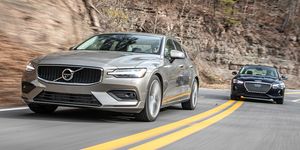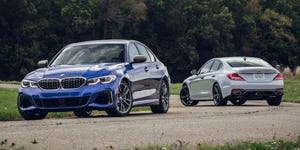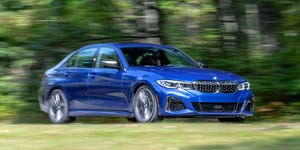Close your eyes, please. Okay, wait. You’ll have to open them if you’re going to read. Did you open them yet? Great. Now, take a nice deep breath. Feel the air rush through your nostrils as your lungs expand. And hold. Two. Three. Four. Now release. Ah . . .
Here we are again, at our center. Driving sports sedans, the vehicles that, more than any others, exemplify the Car and Driver ethos. They’re practical, fun, and relatively efficient. They don’t necessarily need to be from premium brands. If cars like these existed for $15,000 less without the snooty logos punched onto their noses, we’d be into that. But they don’t. Breathe in. Breathe out. Accept.
So here we are with a quartet of luxury sports sedans—two past 10Best winners, one legendary 10Best nameplate, and a Volvo. After a 23-year run, the BMW 3-series fell off our list in 2015. It was all-new for 2019, though, and reactions to encounters with the G20 generation have varied widely depending on how the vehicle was spec’d: engine, tires, suspension, and so on. This one is a 330i, powered by a turbocharged 2.0-liter inline-four, with a base price of $41,245. The $5000 M Sport package (including variable-ratio steering), the $2450 Track Handling package (upgraded brakes, adaptive dampers, and a limited-slip differential), and—ahem—another $10,525 in luxury, tech, and paint options inflate the bottom line to $59,220.
Alfa Romeo just gave the Giulia mild interior and exterior freshenings for 2020, but the company didn’t have any new models available, so we’ve got a 2019. It’s still a strong contender. It landed on 10Best as soon as it arrived on our shores, and the steroid ape of the Giulia family, the 505-hp Quadrifoglio, vanquished a handful of our favorite cars in a comparison test in 2017. Then again, the experience with our long-term QF was so fraught that staff editor Austin Irwin, while rating back-seat comfort, quipped, “This would not be a comfortable place to wait for the tow truck.” This is the 280-hp base model’s first comparison test. It, too, has a turbocharged 2.0-liter inline-four. And here, a full raft of options lifts the price from $44,740 to $52,990.
With the launch of the G70, Hyundai/Kia’s nascent luxury brand, Genesis, has a toehold in its first high-volume segment. True to Korean automotive principles, the G70 borrows freely from the established practices of its competitors and piles on luxury and technology features at considerable savings. Its spec sheet reads like an average of the segment leaders’—and would you look at that? It also has a turbocharged 2.0-liter inline-four! And then there’s the heated and ventilated front seats (with 16-way adjustment for the driver), the 8.0-inch touchscreen, the 19-inch summer tires, and the lowest-in-test price of $44,895.
Chinese ownership has ushered in an interesting new era at Volvo. Also redesigned for 2019, the S60 is striking inside and out—and it’s built in South Carolina now. The only engine available is a honey-ham-burning brick oven with three steam turbines that weighs 3000 pounds. Just kidding. It’s a turbocharged 2.0-liter inline-four, though a Chipotle-like menu of add-ons can take it from 250 horsepower to beyond 400. Want 316 horses? That’d be the T6, which keeps the turbo and adds a supercharger. The T8, with its plug-in-hybrid system, pumps things up to 400 horses. The Polestar Engineered performance variant hits 415. This one, called T5 Momentum, is the base model. It squeezes 250 horsepower from the four-banger. Three hefty option packages cover the luxury, tech, and multimedia bases and help kick the S60’s price from $37,045 to $46,240.
We pointed our group south, hoping to escape the unseasonable cold front that dumped nearly a foot of snow on C/D HQ in early November. In Beckley, West Virginia, we found respite from freezing temperatures only to discover that dewy mountain roads, slick with mud from coal-mining trucks, don’t agree with summer tires much more than ice or sleet does. Keep your eyes open from here on in.
4th Place:
2020 Volvo S60
Highs: Sleek and serene, a comfy place to pass the miles.
Lows: Not interested in your winding roads and squealing tires; artisanal teas, on the other hand . . .
Verdict: A cardigan-pattern vinyl wrap would be fitting—and that’s okay.
As far as any of us can remember, this is the first comparison test we’ve hosted with this much engine similarity among competitors. And yet, every car here has a distinct personality.
The Volvo, with its strong and clear attitude, doesn’t want to be rushed, and neither will its driver. We quite enjoyed a previous encounter with the more firmly sprung T6 R-Design, but we don’t necessarily regret that we didn’t have one for this brouhaha. All our voters liked the S60. It’s just not what we were looking for this time around.
The steering reacts quickly off-center but has a generic, indifferent front-drive numbness to it. And while the Volvo’s body control isn’t sloppy and the car could be pushed to almost keep up, it isn’t ever quite taut enough—or any fun. The transmission is eager to upshift but less so to drop down a gear. And getting caught too low in the rev range exposes the engine’s laggy nature.
The Volvo’s brake pedal is soft from the get-go, but even when we heated the rotors to stinking, it never got any mushier. And more important, the stoppers never faded, turning in a 163-foot stop from 70 mph. That braking result, though last place, is commendable considering only the Volvo wore all-season tires. Still, when we hit the fun roads squiggling through coal country, whoever was driving the Volvo would volunteer to drop to the back of our convoy so as not to hold up the others.
But when the ballots were cast and it was time to turn north and head home, the Volvo driver refused to get out and trade cars with anyone. Cushy front seats and a sleek interior design that should still look stylish 10 years from now make the S60 a great partner for long distances. That goes for the back seat as well, which boasts plenty of room and a cozy armrest—as long as you’re not riding three across.
Remember that line from The Rock, when Stanley Goodspeed, testifying to his unsuitability for the mission at hand, says, “I drive a Volvo. A beige one”? He turned out to be a capable action hero anyway. Not so much with the S60.
3rd Place:
2020 Genesis G70
Highs: Outcorners and outstops the Alfa, rich cabin design.
Lows: Derivative exterior style and that giant grille, lots of noise and vibration.
Verdict: One more leap like this and the G70 will be a full-fledged challenger regardless of price.
It was a bit of a lie to say that each car here has a distinct personality. The G70 is quite obviously mimicking the 3-series in its feel and balance. And in some ways, it betters its benchmark. Tugs and twitches feed back through the steering wheel as cornering forces build and fall, whereas the only tugs the BMW driver feels are when that car’s obnoxious lane-keeping system thinks a crack in the road is a painted line and swerves to follow.
But the Genesis lacks the polish of the BMW and the Alfa Romeo. There’s more shudder through its structure, and midcorner bumps upset it more than they do the two other rear-drivers. And when the driver gets back on the gas, the G70 just spins its inside tire.
The powertrain betrays the G70’s upstart nature. While the power is competitive, its delivery is not. The BMW sings and the Alfa rips, but the Genesis gasps. As in, there’s a lot of intake roar instead of any sort of stirring sound. The transmission feels as if final calibrations haven’t been completed, with some awkwardly timed shifts and others that slur out or slam home inconsistently. We could potentially overlook such powertrain behaviors (considering the cost) if this weren’t the slowest-accelerating sedan in this test.
We have few complaints about the G70’s interior, though. The exuberant design blends a lot of attractive materials without appearing too busy, and the seats are a great balance of comfort and support. Even in this class, cost cutting can be apparent in a car’s secondary controls, but not so in the G70. Take the hard buttons for the touchscreen infotainment system. The upswept shape of their metallic accent strip means there are three button designs where other companies would make do with one. That might seem like a small thing, but in every car company, there are people whose job it is to keep designers from spending money on such things. That those people seem to be tied up in a broom closet somewhere in Seoul bodes well for Genesis.
This is a promising step. Genesis’s corporate parent, Hyundai/Kia, continues to improve its products in gigantic strides. If it can maintain this pace, the next-generation G70 will be an unquestionable class leader. But for now, it’s a spreadsheet car, built to fulfill demands but lacking the emotion and polish that define true greatness. Senior editor Rich Ceppos described the Genesis as “85 percent of the BMW for 75 percent of the price.” It’s a good deal, but there are better sports sedans.
2nd Place:
2019 Alfa Romeo Giulia
Highs: Monstrous power, overflowing with personality.
Lows: Like lots of big personalities, sometimes needs to just calm down.
Verdict: The modern-day sports-sedan archetype doesn’t always feel fully modern.
If you’re looking for a four-door Miata, you might be surprised to find it in an Alfa Romeo showroom. (And if you’re not looking for a four-door Miata, you’re wrong.) But you shouldn’t be surprised, because the Miata is the contemporary re-creation of an old ethos that, decades ago, coexisted in two- and four-door models.
That ethos is, in a word, “spunk.” Or maybe “playful” and very likely “fun.” But it definitely is not “serious.” Like the Miata, the Giulia is surprisingly softly sprung. But that makes managing load transfer easy; the Alfa asks you to drive it actively and rewards you for doing so. And like a Miata, the Giulia has an endearing personality but doesn’t necessarily return the most impressive numbers. Its 159-foot stopping distance and 0.93 g of skidpad stick are just midpack, but its behavior at those limits raises the question of why the heck stability control can’t be fully turned off in something that feels so alive.
The Alfa’s steering reinforces the perception of almost floppy playfulness, with light effort but immediate reactivity. The Giulia feels deft and agile in a pure, joyful way that none of the other cars here come close to replicating. This is the modern sports sedan. What’s remarkable is how Alfa manages to make two versions of the same car, the base Giulia and the Quadrifoglio, so different and yet both so distinctly satisfying.
It’s not the QF’s 505 horsepower, but the grunt that Alfa manages to coax from this 2.0-liter while maintaining tractability and throttle response is nonetheless impressive. While Alfa tunes its ZF eight-speed to shift nearly 1000 rpm earlier than the BMW’s, that gearchange doesn’t seem as premature as it can in other high-boost applications. We can’t think of another turbocharged 2.0-liter inline-four of equal potency that is so well behaved. With 25 more horsepower than the next most powerful car in the test, the 330i, and weighing 56 pounds less, the Alfa carves half a second from the BMW’s 60-mph time, maintaining that lead through the quarter-mile.
But while the Alfa is your best friend on an asphalt EKG, it’s not the all-around crowd-pleaser the BMW is. Regardless of build, our drivers all found the front seats too racy, and after surveying the rears, technical editor David Beard alleged that while the sedans’ interior volumes are all close on paper, the Alfa’s claim must be a lie. “But not in a good way, like the output from that 2.0-liter,” he noted. We also docked the Giulia points for its obtuse infotainment and driver-assistance systems, complaints the 2020 update supposedly addresses.
Such concerns are clearly secondary, though. As a driving tool and a bubbly mechanical companion, the Giulia charms. But the Alfa just doesn’t have the bandwidth of the BMW 3-series.
1st Place:
2019 BMW 330i
Highs: The king of four-cylinders, most of the charm of the Alfa Highs: maturity.
Lows: Too much refinement robs it of engagement, conspicuous lack of steering feel.
Verdict: The inevitable winner not because of sentimentality but excellence.
The B48 2.0-liter debuted in 2014, part of BMW’s then new line of modular engines built around cylinders with 500-cc displacements, a spec that’s now practically industry standard, as our roster here attests. But with the robust low-end torque of a larger engine and the light and free high-rpm pull of a naturally aspirated mill, the B48 is the industry standard. Plus, it has the best EPA fuel-economy estimates of the group and likely only lost to the Volvo in our testing because nobody was inspired to push the S60. And the ZF eight-speed automatic, which is about as common to vehicles as tires at this point, is so smooth and unobtrusive that it feels as though it were developed specifically for this car.
In a region where multiple cars’ navigation systems were mistaking footpaths and coal-mine driveways for actual roads—or otherwise hallucinating roads that simply weren’t there—confidence matters. And the BMW 3-series has it and imparts it.
With its adaptive dampers, the Track Handling chassis provides an ideal balance of compliant highway ride and steady cornering behavior. The 330i is as playful as the Giulia if your right foot asks it to be, but it also lets the driver relax in a way the Alfa doesn’t; maybe it’s smart that you can’t turn off stability control in the Giulia. In the 330i, that button is right there on the center console, and you don’t need to sign a waiver to push it. The steering isn’t what we’d hoped it would be in this generation of 3-series, but the car’s neutral behavior is as welcome and familiar as a hug from your favorite uncle.
If the broad strokes of the car’s behavior are familiar, though, so too are the complaints about BMW’s pricing. But by equipping the 330i with just the $2450 Track Handling package and the $5000 M Sport pack, you’d have a dynamically identical car for $48,695. We’d particularly recommend against opting for the $1700 Driving Assistance Professional package, because BMW’s lane-keeping system stinks. It fights your steering inputs and is constantly correcting itself. Those trucks that paint the lane lines aren’t capable of weaving as much as the BMW does when trying to follow said lines.
As a modern BMW, the 330i offers myriad technologies that distract from its fundamental goodness. But ignore them and the car around you is clearly the product of generations of refinement. It’s barely heavier than the Alfa or the Genesis but feels vastly more solid. The interior design isn’t as exuberant as the G70’s, but like the exterior styling, it is simple and attractive. The driver’s seat doesn’t grab you the way the Giulia’s does, but it offers enough bolstering to keep you in place at 0.99 g or keep you comfortable for a 400-mile trip to Beckley. It’s an all-things-to-all-people-at-all-times kind of car. It’s eye-opening.
From the February 2020 issue.
Tell us what you think. Write to: [email protected] or join Backfires.caranddriver.com
Source: Reviews - aranddriver.com










